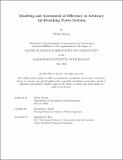Modeling and Assessment of Efficiency in Arbitrary Air-Breathing Power Systems
Author(s)
Giroux, Wyatt
DownloadThesis PDF (2.217Mb)
Advisor
Speth, Raymond L.
Terms of use
Metadata
Show full item recordAbstract
The push for net-zero carbon emissions in the aviation sector by 2050 has resulted in an increasing amount of work being done to analyze the benefits of emergent technologies. Aircraft propulsion systems are a common subject of such research, and studies of some proposed architectures, such as hybrid-electric powertrains, have suggested potential fuel-burn and nitrogen oxide emissions reductions of up to 10% and 4.9%, respectively. When attempting to refine and compare these systems, efficiency is a commonly used metric. Efficiency models provide an understanding of where and how energy is being dissipated in a given system, making them invaluable design and evaluation tools. Until recently, the traditional thermal/propulsive efficiency breakdown has been used to model gas-turbine engines. However, this model has two major deficiencies. First, the lack of a per-component efficiency model restricts understanding of system energy dissipation to either thermodynamic or propulsive losses. Second, the traditional model is unable to capture systems utilizing additional energy sources (batteries, fuel cells, etc.) and their respective conversion pathways. While individual studies have created efficiency models for unconventional systems, these models are either specific to a given architecture or are only applicable to a specific class of engines. This makes comparison between specific terms in existing efficiency models impossible.
This thesis presents the Modular Efficiency Model (MEM), which is capable of constructing low-level efficiency models that accurately represent energy flow pathways and are algebraically consistent across arbitrary collections of propulsion system components. This is done by tracking the kinetic energy flow available for propulsion (expanded flow power) across each component in a system. MEM provides a more detailed breakdown of useful energy dissipation, relative influence of streams and components, and individual powertrain efficinecies that can be meaningfully compared to other systems. MEM is demonstrated in this work by comparing performance of unmixed, mixed-flow, and hybrid electric engine architectures. We identify high fan pressure ratio systems with low fan diameter as candidates for effective mixer use. For hybrid-electric systems, we find a 3.2% reduction in whole-mission fuel burn is possible at the cost of carrying only 50% of the original aircraft payload. Numerous detailed future studies utilizing MEM are recommended, using this thesis as a baseline example for the use of MEM in analyzing and comparing novel architectures.
Date issued
2024-05Department
Massachusetts Institute of Technology. Department of Aeronautics and AstronauticsPublisher
Massachusetts Institute of Technology